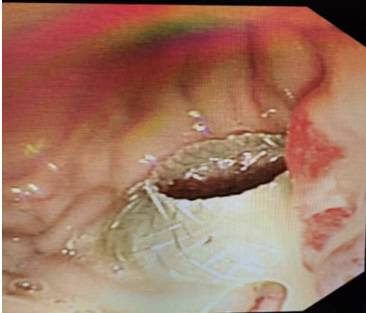- News
The Team of Prof. Rong Wan in the Department of Gastroenterology at Shanghai General Hospital Performed EUS-guided Cyst Puncture Drainage for A 9-year-old Child to Treat Complications After Severe Pancreatitis
Link of the original article:
https://mp.weixin.qq.com/s/7iYXyZwllmbTBsX6Bngvng
Recently, Professor Rong Wan, Executive Director in the Department of Gastroenterology at Shanghai General Hospital performed endoscopic ultrasound (EUS)-guided cyst puncture drainage for a 9-year-old child with severe pancreatitis complications.

Due to long-term suffering from anorexia and vomiting caused by "pancreatic pseudocyst", the child weighed only 20 kg before the surgery, and the surgery was very difficult. Professor Rong Wan's team successfully completed the surgery with a new "electroresection and drainage integrated stent" to overcome difficulties such as insufficient operating space.
The child who underwent the surgery was Minmin, a 9-year-old girl from the western region. Last July, Minmin was diagnosed with acute necrotizing pancreatitis at the local provincial hospital. After several months of hospitalization, the inflammation was controlled, but it was complicated by one of the common complications of pancreatitis, the pancreatic pseudocyst. Since then, the family has traveled to many places, and has tried a variety of treatment methods such as "percutaneous puncture drainage" and "ERCP drainage", yet the lesions gradually increased. Minmin was also suffering from intermittent fever, abdominal pain and bloating, anorexia, frequent vomiting after eating, and in just half a year, her weight dropped to only 20 kg. She even had to suspend her studies.

Successfully inserted AXIOS electrocut drainage integrated bracket
Professor Rong Wan, Executive Director of the Department of Gastroenterology of our hospital, decided to admit her to the hospital after a detailed interrogation and examination. Considering her condition including her age, weak constitution, thin stomach wall, narrow gastric cavity space and other factors, the surgery is rather difficult. And in addition to achieving the goal of treatment as much as possible, it is also necessary to fully consider the long-term quality of life after surgery. The gastroenterology team conducted a thorough preoperative evaluation for Minmin and finally chose the difficult but more beneficial "endoscopic ultrasound (EUS)-guided cyst puncture drainage".
On the day of surgery, the surgical team first used endoscopic ultrasound to accurately locate the cystic lesion about 12 cm in size at the tail of the pancreas, and then punctured with a 19G needle to avoid the main blood vessels. As the needle is inserted, a large amount of tan cloudy sac fluid gushes out, which is the root cause of the patient's repeated infections. After rapid X-ray positioning, the surgical team used the new "AXIOS electroresection and drainage integrated stent" for follow-up operation to reduce intraoperative instrument exchange, reduce the risk of internal fistula and bleeding while performing efficient drainage. Professor Wan Rong accurately operated the endoscope and appendages to cut the gastric mucosa and cyst wall layer by layer, and sent the stent into the cyst cavity. The patien’s stomach cavity is small, and the surgery space is very limited. Professor Rong Wan repeatedly tried the most suitable release position, and finally released the stent head with a special "fundus orientation position". After the placement is completed, it can be seen that the metal stent in the stomach is in place and the cyst fluid is drained smoothly. With the joint efforts of the anesthesiology department and the nursing team, the operation was completed in less than 1 hour.

After surgery, the medical team conducted two examinations for the patient, and the results showed that her infection indicators decreased significantly. Abdominal ultrasound on the second day after surgery showed that the cystic lesions had rapidly shrunk from the original 8.9*12.0 cm to 1.1*1.7 cm. Minmin’s life returned to normality, and will soon return to school.
According to the reports, pancreatic pseudocysts are more common in severe acute pancreatitis, chronic pancreatitis and pancreatic injury. Traditional treatments include surgery and percutaneous puncture and drainage. The former is more traumatic and has more postoperative adverse reactions; The latter is prone to incomplete drainage, infection and recurrence. The endoscopic ultrasound guided puncture and drainage of pancreatic pseudocyst carried out by the Department of Gastroenterology of our hospital is accurate, and the patients have less pain, faster recovery, and lower complication and recurrence rates than traditional methods.
Correspondent: Weiliang Jiang, the Department of Gastroenterology, Yang Hu, the Department of Publicity, Shanghai General Hospital
Editor: Shishi Cai, the Department of Publicity, Shanghai General Hospital
